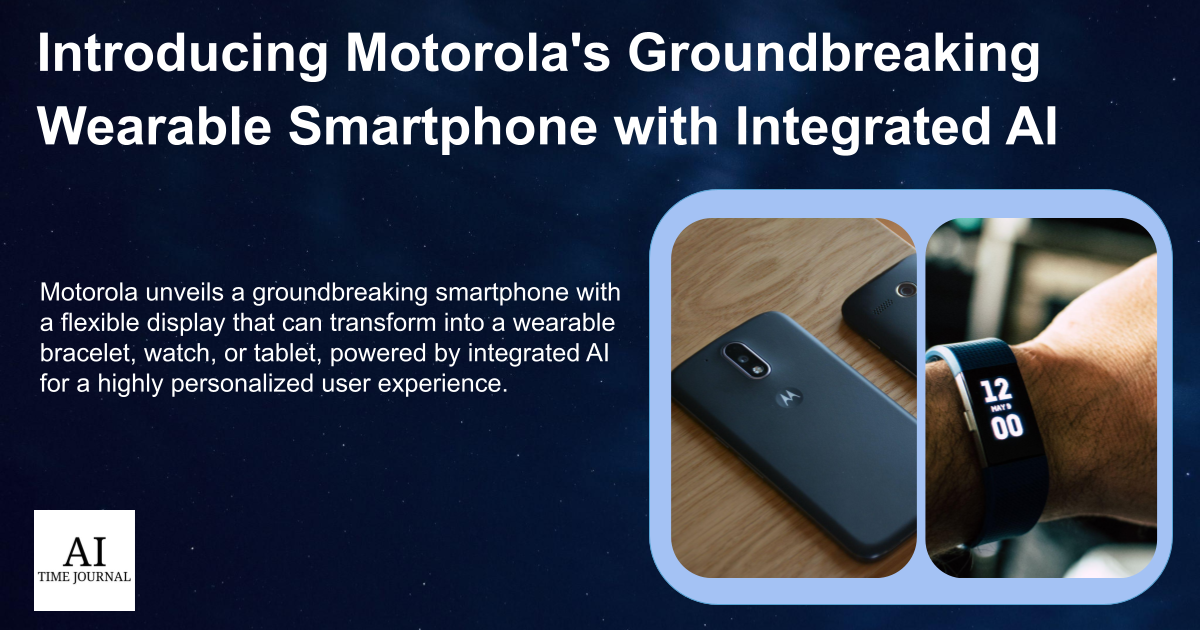Smartphones have come a long way since their inception, evolving from bulky devices that could only make calls and send messages. To eventually evolve into powerful pocket computers that can run multiple applications, access the internet, and capture high-quality photos/videos. Alongside smartphones, wearable technology has also emerged as a new frontier of innovation, offering users convenient and personalized ways to monitor their health, fitness, and notifications. But what if you could combine the best of both worlds and have a smartphone that can also be worn as a wearable device? This is the vision of Motorola, which has recently unveiled its groundbreaking adaptive display concept, a smartphone that can wrap around your wrist like a bracelet or watch, or even stand on its own like a mini tablet.
This device features a flexible pOLED screen that can bend and adapt to different shapes and modes, as well as an integrated artificial intelligence (AI) that can optimize the user experience and functionality. In this article, we will take a look into Motorola’s ground-breaking wearable smartphone as well as examine its features, advantages, and possible effects on mobile technology in the future.
The Rise of Wearable Technology
Wearable technology is a term that refers to any electronic device that can be worn on the body, either as an accessory or as part of clothing. Wearable devices can perform various functions, such as tracking health, and fitness, providing entertainment, enhancing communication, or augmenting reality. The market for wearable technology has been expanding quickly in recent years due to the rise in smart and connected device demand, advancements in sensor and battery technologies, and the introduction of novel use cases and applications. Grand View Research’s analysis estimates that the worldwide wearable technology market will reach a valuation of USD 61.30 billion in 2022 and increase at a compound annual growth rate (CAGR) of 14.6% between 2023 and 2030.
Some of the other key players in the wearable tech industry include:
These companies offer a variety of products, such as smartwatches, fitness trackers, smart glasses, smart earbuds, smart rings, and smart clothing. For example, Apple is the leader in the smartwatch segment, with its Apple Watch series that can monitor heart rate, blood oxygen, sleep, and activity. Along with those health features the Apple watch also provides notifications, music, and Siri voice assistant. Motorola, on the other hand, is the pioneer in the wearable smartphone segment, with its Moto Z series that can transform into a smartwatch, a projector, a speaker, or a camera, thanks to its modular design and Moto Mods accessories.
However, the field of wearable technology also faces some challenges and limitations, such as privacy and security issues, user acceptance/adoption, battery life, durability, compatibility, and regulatory concerns. For instance, wearable devices can collect and transmit sensitive personal data, such as location, biometrics, and health information, posing risks of hacking, identity theft, or unauthorized access. Additionally, wearable technology can bring up social issues, such as how it affects identity, human behavior, and interaction in individuals as well as what it means for autonomy, dignity, and human rights.
Motorola’s Innovative Approach
Although they are not a new player in the smartphone space, Motorola is unquestionably a pioneer in the area of flexible and wearable technology. As we teased earlier the company has just debuted its adaptive display concept phone, which can be twisted and curved into multiple forms according to customers’ requirements and preferences. This phone is more than just a device—it’s a style accessory that may fit your personality.
This innovative device, which was showcased at the Lenovo Tech World 2023, is expected to have a significant impact on the wearable technology industry and pave the way for future developments. The adaptive display concept phone is powered by a flexible pOLED screen that can offer a 6.9-inch display when flat, or a 4.6-inch display when curved. The phone can be worn like a bracelet or a watch, thanks to a magnetic clasp that attaches to a fabric backing. The phone can also be propped up on a table or desk for viewing or folded into a compact shape for easy storage.
But the phone is not just about the display. It also stands out from the competition thanks to a variety of cutting-edge features and capabilities. One of the main features that sets this phone apart from others is the incorporation of AI for an improved user experience. MotoAI—a personal assistant built on ChatGPT-like technology—is a feature of the phone. It can perform nearly any task you may ask of AI right on your wrist. Additionally, MotoAI is a conversational AI agent that can comprehend your context, preferences, and emotions in addition to being a voice assistant. It can also make tailored recommendations. MotoAI may learn from your actions as well as adjust to your needs over time, enhancing the intelligence and user-friendliness of your phone. For instance, the phone has a generative AI feature that can take a picture of your outfit and automatically generate a matching wallpaper, ensuring your wearable phone matches your fashion and style every day.
The phone also stands out in the competitive market, as it offers a unique combination of flexibility, functionality, and fashion. No other phone out right now can match the versatility and customization that this phone provides, as it can transform into different shapes and styles according to your preference. The phone also offers a seamless and immersive experience, as it integrates AI into every aspect of your phone usage, from the wallpaper to the assistant. The phone is not just a device, but an extension of yourself.
AI-Powered Functions and Applications
In this section of the article, we will now go through a detailed exploration of more AI-driven features that we have not yet covered, that describe why this product is so revolutionary. First is the device’s AI-powered security features that are designed to keep the user’s data safe and secure. The feature uses machine learning algorithms to detect and prevent unauthorized access to the device. Next up, is the AI-powered translation feature that uses machine learning algorithms to translate text and speech in real time. The feature can translate between multiple languages, which makes it an essential tool for international travelers. Also, the phone has AI-powered entertainment features designed to provide users with a personalized entertainment experience. The feature can recommend movies, TV shows, and music based on the user’s preferences and habits. Finally, an AI-powered navigation feature uses machine learning algorithms to provide users with the most efficient route to their destination. The feature considers real-time traffic data, weather conditions, and other factors to provide users with the fastest and safest route possible.
Here are some of the use cases to say why a wearable smart with integrated AI is more beneficial is beneficial for its users.
- Health and Fitness – The device’s AI-powered health and fitness features are designed to help users stay healthy and active. The device can track the user’s steps, heart rate, and sleep patterns, providing valuable insights into their overall health. With the device always on your body and readily available it does a better job at tracking these things than other phones out there.
- Communication – The device’s AI-powered communication features are designed to make it easier for users to stay connected. The device can automatically respond to messages and emails, making it an essential tool for busy professionals.
- Daily Life – The device’s AI-powered features are designed to make everyday tasks easier. The device can provide directions, set reminders, and even order food, making it an essential tool for anyone who wants to simplify their life.
User Experience and Convenience
One of the most appealing features of the Motorola wearable smartphone is its ability to improve user experience and convenience. Unlike conventional smartphones, which require users to hold them in their hands or carry them in their pockets, the Motorola wearable smartphone can be bent and shaped into different forms depending on users’ needs, like wear it like a bracelet or a watch on their wrist. Or if you are watching a movie, a show, or an informative lecture, prop it up on a table or desk for viewing. Or use it as a normal smartphone display when flat.
The role of AI in personalizing this device is crucial, as it enables users to have a more natural and intuitive interaction with their wearable phone. MotoAI can understand users’ commands, questions, and emotions, providing relevant responses and suggestions. An example of MotoAI learning from users’ behavior and preferences is it can adjust the brightness, volume, and notifications of the device based on the time, location, and context of the user.
The Future of Wearable Technology
In addition to being a novel idea, Motorola’s flexible phone represents a significant advancement in wearable technology that has the potential to completely change how we interact with our surroundings, communicate, and get information. Motorola’s proposal delivers a new level of personalization and user experience by fusing the features and convenience of a wearable device with the capabilities of a smartphone. The following are some implications of Motorola’s innovation:
- It could challenge the dominance of traditional smartphone makers and create a new niche in the market for wearable smartphones.
- It might improve the incorporation of generative AI, augmented reality, virtual reality, and biometric sensors, among other cutting-edge technologies, into wearable technology.
- Consumer demand and acceptance of wearable technology may rise as a result, particularly among younger generations who place a high value on portability, style, and convenience.
Motorola’s flexible phone concept is still in the prototype stage and has not been released to the public yet. However, once it is available, it could open up new possibilities and opportunities for further innovation and improvement. Some of the potential advancements and future developments are:
- Improving the durability, battery life, and performance of the flexible display and the device itself, as well as reducing the cost and increasing the availability.
- Developing new features and applications that leverage the adaptive design and the wrist-wrapping capability of the device, such as gesture control, health monitoring, fitness tracking, and gaming.
- Creating new accessories and customization options for the device, such as magnetic bracelets, fabric backings, leather bands, and different colors and patterns.
The wearable smartphone market is still in its infancy, but it is expected to proliferate in the coming years, driven by the increasing popularity and innovation of wearable technology. The emergence of new competitors and products in the wearable smartphone market, such as Samsung, Huawei, LG, and Apple, could offer their versions of flexible phones or other wearable devices with smartphone capabilities. The evolution of consumer preferences and expectations for wearable devices, such as the demand for more functionality, convenience, style, and personalization. These are just some of the factors that could influence the growth and trends of the wearable smartphone market.
Conclusion
To sum up, Motorola’s recently released adaptable display concept phone is a ground-breaking development in wearable technology. This unique gadget offers consumers a highly personalized and intuitive experience by fusing the capabilities of a smartphone with the adaptability and convenience of a wearable device. The phone’s embedded AI and flexible display technology enable it to change into various modes and shapes based on the needs and tastes of its users. Motorola’s innovative design, which is currently at the prototype stage, suggests a bright future where wearable technology offers optimal portability, total customization, and seamless AI integration.
Should customers adopt this technology, it has the potential to upend the smartphone industry and spur innovation in the wearables space. As device performance improves and costs decrease, adaptive wearable smartphones may become the norm. Motorola’s design shows that we are entering an era of truly smart, customizable technology that adapts to users just as much as users adapt to it.



